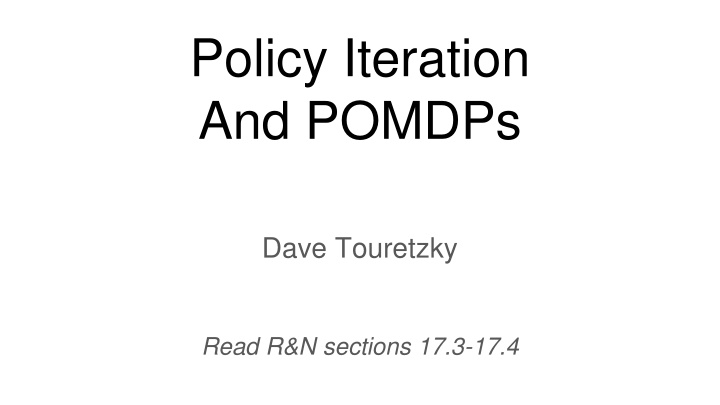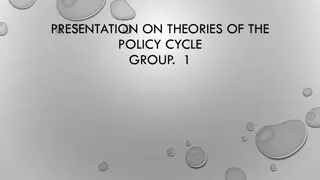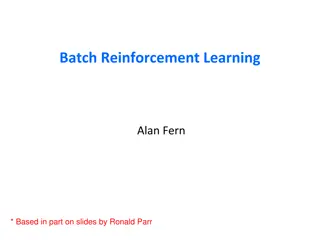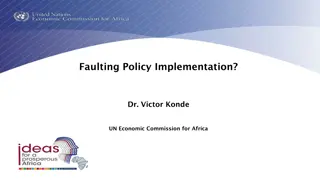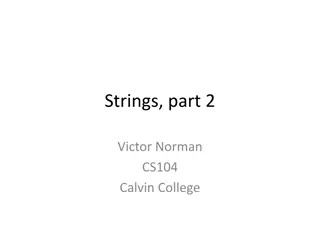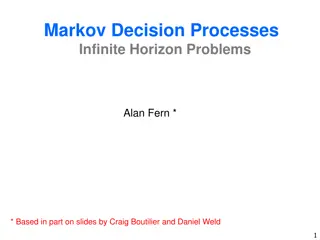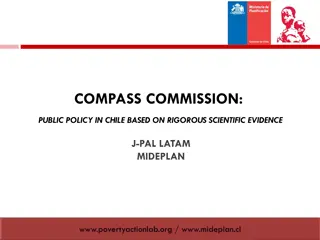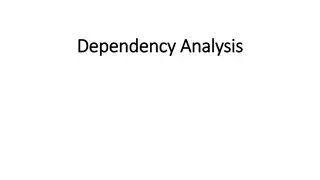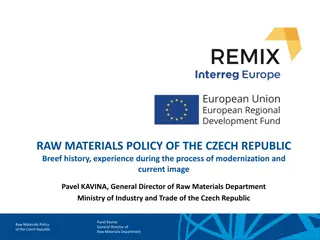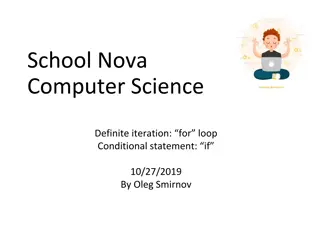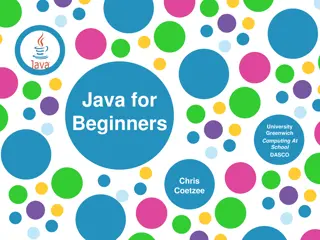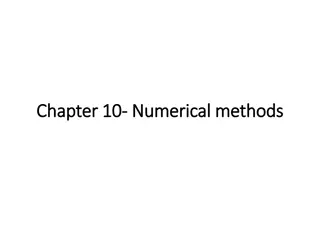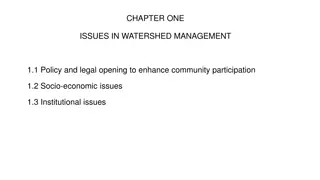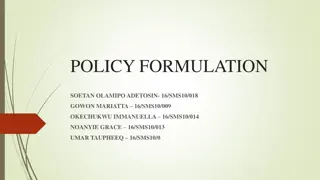Policy Iteration And POMDPs
Explore the concepts of policy iteration, Bellman equation, value iteration, and convergence in Markov decision processes (MDPs). Learn about the iterative computations involved in determining optimal policies and utility functions in grid worlds. Understand the convergence properties of value iteration and the importance of contractions in the update process.
Download Presentation

Please find below an Image/Link to download the presentation.
The content on the website is provided AS IS for your information and personal use only. It may not be sold, licensed, or shared on other websites without obtaining consent from the author.If you encounter any issues during the download, it is possible that the publisher has removed the file from their server.
You are allowed to download the files provided on this website for personal or commercial use, subject to the condition that they are used lawfully. All files are the property of their respective owners.
The content on the website is provided AS IS for your information and personal use only. It may not be sold, licensed, or shared on other websites without obtaining consent from the author.
E N D
Presentation Transcript
Policy Iteration And POMDPs Dave Touretzky Read R&N sections 17.3-17.4
A grid world MDP Assume reward R(s) = -0.04 for non-terminal states. Actions = {Up, Down, Left, Right} 2
The Bellman equation A state s utility depends in part on the utilities of its successor states. This is expressed by the Bellman equation, which defines U(s) in terms of U(s ): U(s) = R(s) + ? maxa s P(s | s,a) U(s ) Example: for state (1,1) in our simple MDP: U(1,1) = -0.04 + ? max [ 0.8 U(1,2) + 0.1 U(2,1) + 0.1 U(1,1), (Up) 0.9 U(1,1) + 0.1 U(1,2), (Left) 0.9 U(1,1) + 0.1 U(2,1), (Down) 3 0.8 U(2,1) + 0.1 U(1,2) + 0.1 U(1,1)
Value iteration The Bellman equation describes a fixed point for U. We can reach that state by an iterative computation called value iteration. Let Ui(s) be the utility of state s on the ith iteration. Bellman update: Ui+1(s) R(s) + ? maxa s P(s | s,a) Ui(s ) Value iteration is guaranteed to converge to a unique solution U*. A policy *(s) that uses U*to evaluate actions will be an optimal policy. 4
function VALUE-ITERATION(mdp, ) returns a utility function U(s) inputs: mdp, an MDP with states S, actions A(s), transition model P(s | s,a), rewards R(s), discount factor ? , the maximum error allowed in the utility of any state local variables: U, U vectors of utilities for states in S, initially zero ?, the maximum change in the utility of any state in an iteration repeat U U ; ? 0 for each state s in S do U [s] R(s) + ? maxa s P(s | s,a) U[s] if |U [s] - U[s]| > ? then ? |U [s] - U[s]| until ? < (1-?)/? return U 5
Convergence of value iteration A contraction is a function f(x) such that the distance from f(a) to f(b) is strictly less than the distance from a to b. Example: f(x) = x/2 is a contraction with a fixed point at 0. A contraction has exactly one fixed point. Why? 6
Belman update as contraction Regard the Belman update as an operator B: Ui+1 B Ui Define the max norm to measure the length of a utility vector as the absolute value of the largest component: ||U|| = maxs|U(s)| Define the distance between any two utility vectors as ||U-U ||. The Belman update is a contraction by a factor of ? (proof omitted): ||B Ui- B Ui || ?||Ui- Ui || 7
Rate of convergence Let U be the true utility, for which B U = U. ||B Ui- U|| ?||Ui- U|| ||Ui- U|| is the error in the estimate Ui, and it decreases by a factor of ? with each update. So value iteration converges exponentially fast. Error bound: if updates are small and ||Ui+1- Ui|| < (1-?)/?, then ||Ui+1- U|| < . This is the termination condition used in value iteration. 8
Less discounting means slower convergence Max error is c Rmax. 9
Whats the problem with value iteration? On every iteration i, value iteration evaluates the utility of every action in every state, and for each state, picks the action with highest utility. Thus, it effectively creates a new policy ion each iteration. It does this using the max function, which is nonlinear. U(s) = R(s) + ? maxa s P(s | s,a) U(s ) Nonlinearity The end result is the true utility U*, which gives us the optimal policy *. But are there more efficient ways to get there? 10
Policy iteration What we really want to do is find the optimal policy *, which can be done even if the utility function U(s) is only approximate. So search the space of possible policies . This space is finite. With n states and b actions per state, there are bnpolicies. Policy iteration in a nutshell: 1. Start with an arbitrary policy 0. 2. With each iteration i, evaluate the policy ito obtain Ui. 3. Formulate an improved policy i+1by selecting the best action for each state s according to Ui(s). 11
function POLICY-ITERATION(mdp) returns a policy inputs: mdp, an MDP with states S, actions A(s), transition model P(s | s,a) local variables: U, a vector of utilities for states in S, initially zero , a policy vector indexed by state, initially random repeat U POLICY-EVALUATION( , U, mdp) unchanged? true for each state s in S do if maxa s P(s | s,a) U(s ) > s P(s | s, [s]) U(s ) then do [s] argmaxa s P(s | s,a) U(s ) unchanged? false until unchanged? return 12
The policy evaluation step In order to improve on the current policy we need to know U so we can evaluate all possible actions at every state. But U is easy to compute. Why? Since we re following the policy: U(s) = R(s) + ? s P(s | s, [s]) U(s ) No nonlinearity! With n states there are n of these Bellman equations, but they re linear. Can solve in one step as a series of linear equations. But this takes O(n3) time. Could take a while if n is large. 13
Cheaper policy evaluation We don t need an exact solution to U . We just need something good enough to find an improvement on . Solution 1: approximate U by doing a few steps of simplified Bellman update: U(s) R(s) + ? s P(s | s, [s]) U(s ) This is called modified policy iteration. Solution 2: instead of updating U(s) for all states, just update for some subset of the states on each iteration. Pick states that are most likely to be reached by a good policy. This is known as asynchronous policy iteration. 14
Learning the MDP model Up to now we ve assumed that the rewards R(s) and the transition model P(s | s,a) were known. What if they need to be discovered? Reinforcement learning can be used to learn these functions. One approach, Q-learning, learns the utilities Q(s,a) of state-action pairs. Reinforcement learning will be covered next week; see R&N Ch. 21. These algorithms still assume that states are fully observable. But what if we can t be certain what state we re in? 15
POMDPs: Partially Observable Markov Decision Processes 16
Defining POMDPs In an MDP we know the state s at every time step. In a POMDP we still know the transition model P(s | s,a), but we don t know the actual state we re in. Instead we have a belief state b(s) at every step, expressed as a probability distribution over possible states s. We also have a sensor model P(e | s) that specifies the probability of seeing evidence e given state s. We use this to update the belief state. 17
Grid world as a POMDP We don t know our actual state. Assume initial belief state is uniformly distributed over the 9 nonterminal grid squares. Assume the sensor model reports only the number of adjacent walls: either 1 or 2. (Value is 2 for all non-terminal states except in the third column.) Assume the sensor model is noisy and returns the wrong value 10% of the time. 18
Belief state update Suppose when the agent is in belief state b(s) it takes action a and receives percept e. The new belief state b should be: b (s ) = P(e|s ) sP(s | s,a) b(s) where is a normalizing constant. Look closely: this is an application of Bayes rule. 19
Belief state update P(e,s | a,b) b (s ) = P(e|s ) sP(s | s,a) b(s) P(s | a,b) P(s | a,e,b) 1 / P(e) 20
Action selection in a POMDP The optimal action depends only on the agent s current belief state b. It doesn t matter that we don t know the actual state s. The policy function is a function over belief states: (b), not (s). Since belief states are probability distributions, there are infinitely many, so policy functions have an infinite domain. There are thus an infinite number of policies. 21
POMDP decision cycle 1. Given the current belief state b, execution the action a = *(b). 2. Receive the percept e. 3. Set the current belief state to FORWARD(b, a, e) and repeat. Here, FORWARD is the update step used in recursive state estimation (see R&N Ch. 15). 22
Reward function in POMDPs As in an MDP, each state s has a reward R(s). But we don t know s, only b. Expected reward for a belief state b: (b) = sb(s) R(s) 23
Sensor prediction based on belief state and action P(e | a,b) = s P(e | a,s ,b) P(s | a,b) = s P(e | s ) P(s | a,b) = s P(e | s ) sP(s | s,a) b(s) 24
Transition model for belief states From a belief state b and action a we can derive an a priori belief state b before seeing any evidence: marginalize over e. P(b | a,b) = eP(b | e,a,b) P(e | a,b) = eP(b | e,a,b) s P(e | s ) sP(s | s,a) b(s) Where P(b | e,a,b) is 1 if b = FORWARD(b,a,e), else 0. 25
Solving POMDPs We have defined a belief reward function function (b), and a belief transition model P(b | a,b). Beliefs are fully observable. Therefore, we have an MDP in belief space describing the POMDP. In principle we can solve this MDP using value iteration. In practice, this is very expensive, even for tiny problems. More efficient approaches to solving POMDPs are a topic of current research, and are outside the scope of this course. 26
